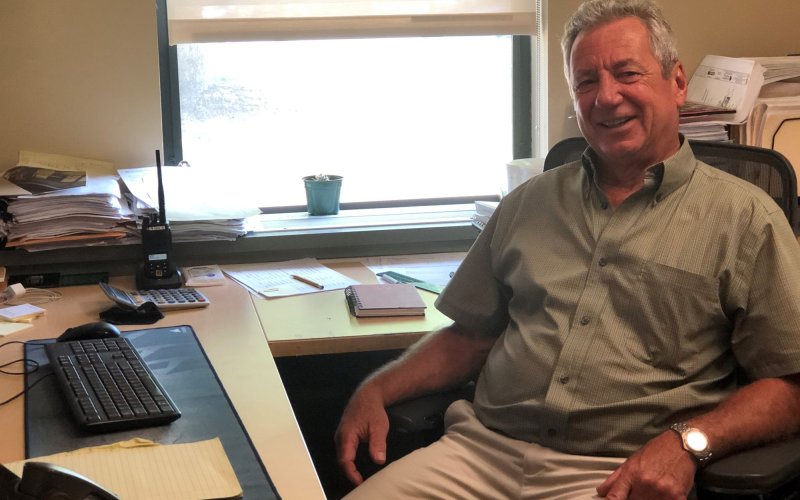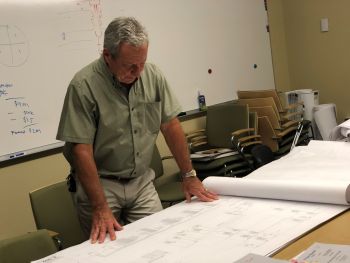Keeping the Campus Humming: A Q&A with Michael Vadney

ALBANY, N.Y. (Aug. 30, 2022) — The University at Albany covers more than 500 acres, with 143 buildings, 12 miles of road, 6 miles of sanitary sewer pipe and 16.5 miles of storm sewer pipes. The Uptown Campus has four fountains, around 3,500 trees and 140 planters. Windows? There are 10,000 on the Academic Podium alone, a massive structure that includes 13 three-story buildings interconnected through basement and tunnel levels, and more than 900,000 square feet of walking surface. The four residential quads each sport eight three-story buildings and a central 23-story tower – and together have 14,000 windows.
Who takes care if it all? The 425 physical plant workers — including carpenters, plumbers, electricians, mechanics, painters, masons, grounds crew and custodians. The gang is headed by Interim Director of Physical Plant Michael Vadney, who started working at the University in 1994 as an electrician. Since then, he’s been a construction project manager and shop coordinator, ran the customer service center and was assistant director. “So here I am today, answering questions for the entire plant facilities department as interim director,” he said. “As they say, time flies when you are having fun. And I am being very truthful — it has been fun!”
Vadney and his wife have two grown children and one grandchild – the lovely Sophia. He took a little time out of his busy week to answer some questions about running the campus.
What time of year is the most challenging for Facilities?
Certainly any of the school break periods — summer, winter and spring. This is our opportunity to get into the classrooms and private offices to paint or repair damages. During the school year we are mostly limited to the public area’s hallways, corridors, outside or in our machine rooms and electrical and data closets. The summer is about the only time we get a chance to get into the dorm rooms for a full 60 days to evaluate, clean and repair 2 million square feet of residential area.
What were the special challenges of the pandemic?
It was very tough and a real challenge to keep morale up. During this period projects stopped, there was a freeze on hiring, overtime work was out of the question, and we were asked (as all departments were) to cut staffing. At the same time, the campus was just about to open the new ETEC building.

Facility operations does not slow down when nobody is here. Snow still needs to be shoveled, grass grows, heat needs to stay on, and water needs to continue to circulate. Facilities workers are the shepherds of this state asset 24/7/365 — pandemic or not. We started to look at cross training individuals to work wherever we needed them. We were also able to promote from within to fill positions as people retired. A bit of restructuring occurred, bringing in new energy and new eyes to evaluate the problems we faced.
I think this slowly enabled people to see the light at the end of the tunnel. It was a great relief to see the students come back and things slowly start to get back to normal. I will say that I will never forget how these workers overcame all those obstacles and stuck together, watching out for each other and pitching in where needed. Our facilities essential workers are true heroes!
What are some of the initiatives going on in facilities that make the campus more sustainable?
I would be stealing [Energy Officer] Indu or [Director of Sustainability] Mary Ellen Mallia’s thunder here, but we have assisted both those superheroes on green initiatives. Our electricians installed the vehicle charging stations around campus and are scheduled to install more. We are purchasing more electric vehicles and electric carts on our next round of vehicle upgrade. We are assisting Jason Jones in Parking Management on his charger for the new electric trolley that you will be seeing real soon. We are working with the design engineers and contractors building the new bus route through campus. We installed the first cardboard compactor (years back) on campus for UAS and the main Campus Center kitchen.
Of course, we manage and maintain all the computerized Building Management Systems here on campus and are working on having them tied into a more global INDUSOFT program for monitoring and energy management. We maintain the geothermal fields for heating and cooling at Liberty Terrace and ETEC, and we are proud to send power back to our grid via the new 2.3-megawatt solar array on top of the Academic Podium. We maintain all Uptown Campus street and walkway lighting, which was recently upgraded to LED for energy efficiency.
Much of the Uptown Campus was built at the same time, which means buildings have aging problems at the same time. How does that impact maintenance and upkeep?
This is a big problem, especially with the campus’s unique design by Edward Durrell Stone. The Uptown Campus has just about the same amount of concrete as the Pentagon. We maintain it all with two full-time masons and two full-time roofers — the busiest guys in the world!
Scheduling full gut rehabs is the best way of maintaining a building, but you must relocate people and students, so it is a juggling act. This year Colonial’s Paine and Zenger halls are being fully renovated, as are the SEFCU Arena and the Physical Education Building. There are designs in place to renovate the Earth Science building, and the main fountain is back on the schedule for upgrades. In many of the buildings we have updated the network controls for our air handling units, which are 50 years old. We have miles and miles of piping and wiring, all from day one, still operating. I would like to think it still ticks because we have some great mechanics working here.
The Downtown Campus must have its own set of challenges, with buildings dating from the early 1900s. What special issues do you deal with there?
Those structures where amazingly built with brick and mortar but there are the typical older building issues. Moisture problems, no air conditioning in most buildings, older plumbing and electrical still exists in areas.
What’s your favorite spot on campus?
On top of the water tower in the main fountain. Seriously, someone has to climb up it and reprogram the lights on top. The tower is 164 feet tall, 18 feet in diameter and holds 311,000 gallons of water. To get up, you climb, hand over hand, 22 stories up a ladder. I think last time was my last time – I’ll leave that fun to someone younger.
If you could invent something that would make campus better, what would it be?
That’s a tough one. Take a look around campus the first couple of weeks of the fall semester and you will see and almost feel an energy or a vibe of positivity and happiness — just excitement about the newness of what lies ahead. I would try to invent an air handler that would deliver a breath of that same peace and happiness for students’ entire college stay.




